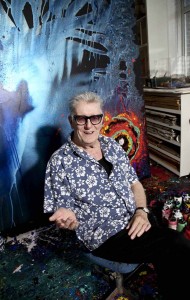About
John Hoyland (1934-2011) was one of the leading British painters of his generation.
As the critic William Feaver once wrote, ‘A pukka Hoyland is a work not of hand and eye, but of total Self.’ And it was this whole-hearted commitment to painting that characterised his six decades of work. His career was decisively influenced in the late 1950s and 1960s by his experience of American Abstract Expressionism. But as an artist and a man he was enough of an individual to be able to knowingly absorb and deflect those influences, and set himself on his own path.
Hoyland preferred not to be known as an abstract painter. He felt it too calculating a term or that it implied some kind of premeditation in his process. After an initial dalliance with figurative painting in the 1950s he became a life-long proponent of the possibilities of non-figurative imagery, which possessed for him, he once wrote, ‘the potential for the most advanced depth of feeling and meaning’. As Andrew Lambirth writes: ‘His paintings are abstracts but they are not about absolutes. They are about contingencies and specifics: very particular emotions, thoughts and feelings dependent upon the act of looking.’
